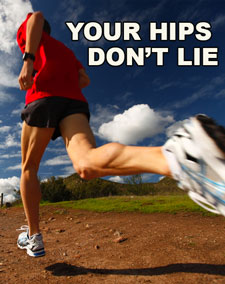Happily Hipster
A new movement has been gaining momentum over the last several years: runners going hipster. No, I don’t mean dressing fashionably vintage while listening to anything but mainstream music and sipping on artisanal coffee. I mean runners have finally realized that Happy Gilmore's coach, Chubbs, was right all along: "It's all in the hips."
In 2007, Dr. Reed Ferber, Ph. D., director of the University of Calgary's Running Injury Clinic, championed a belief that most of the foot, ankle, or knee pain runners encounter stems from poor hip function. "Inadequate hip muscle stabilization is a top cause of injury in runners," he says.  "The hips need to be strong to support the movement of the feet, ankles, and knees."
"The hips need to be strong to support the movement of the feet, ankles, and knees."
According to Ferber, the most common running injuries, patellofemoral syndrome, Achilles tendinitis, and iliotibial band syndrome, are due to weak hips. He conducted a study of 284 patients who complained of leg pain. He found that 93 percent of them had weak hip muscles. After putting these people on a targeted strength program, 90 percent of them were pain-free within six weeks. Subsequent studies continue to reaffirm his proposition.
A runner’s stride originates from his or her pelvis. The pelvis must be stable and neutral to propel the stride through its full extension, and therefore drive a runner forward. Think of your body like a bench press: you develop strong legs from all the miles you log—that’s one giant weight on one side of the bar. You develop a very efficient cardiovascular system to transport oxygen to the working muscles—that’s an equally giant weight on the other side of the bar. Now picture your hips and core as the bar. If your hips and core are weak, it’s like using a bar made of rubber or rope. You won’t be able to lift efficiently, and you’re probably going to get hurt. You need to have strong enough hips to allow your pelvis to stay in a stable position throughout the gate cycle.
One of the big problems for many of us is that modern lifestyles contribute to muscle weaknesses and imbalances that cause runners so many problems. We spend so much of our time sitting in a static, flexed position—which is actually the complete opposite of running. We are literally training our hips to be weak. As the saying goes, “The human body does best what it does most often.” We sit at desks, in the car, and on the couch. Eight or more hours a day in a seated position leads to soft tissue restrictions in the hip flexors and quads. It also causes gluteal amnesia (our butts forget how to work). All that sitting causes the hip abductors and external rotators to shut off. As a result, those muscles atrophy and forget how to work smoothly and in sync with the rest of the surrounding muscles.
To make matters worse, our bodies have a remarkable ability to cheat and find ways to compensate—or get the job (or run) done. Our bodies recruit the wrong muscles to help us accomplish our daily miles. Not only does this overuse the muscles, but it puts our bodies in an inefficient position. (It’s the old, “Lift with your legs, not with your back” adage.) Inflammation and muscle restrictions slowly but steadily stack on top of one another. And soon, an injury (or injuries) rears its ugly head.
“Great, Tim. So you’re saying that because I sit at work, I’m doomed to be an inured runner forever?”
Never fear. We don’t have to be injured all the time. We just need to recognize the issues and address them. As Dr Ferber's study found, with a targeted strength program, we can continue our lifelong love of running. The key phrase here is “targeted strength program.” Simply hitting the gym and knocking out squats isn’t going to help. If we have already developed muscle compensations and incorrect form, then we will do those lifts incorrectly (the compensating muscle will act in place of the muscle that should be doing an action), and make the whole issue worse.
The primary focus when developing a program is to discern if the cause of your problems is hip weakness, hip inhibition, or both. By training movement and not muscles, we can attack both problems. As the saying goes, "Do it light, do it right." As we develop the muscle's ability to fire properly, and also improve its mobility, we can gradually strengthen it. By “turning on” the proper muscles, we will be able to alleviate the primary cause of many running injuries. That means we will be healthier runners, more efficient runners, and, yes, faster runners.
No runner has everything working perfectly at the same time. When you consider we take approximately 1,800 steps per mile, it's easy to understand why it doesn't take long for some sort of compensations to occur. By staying ahead of the curve and participating regularly in a hip strengthening program, you can enjoy happier, healthier, and faster runs. Because, as Shakira says, "The hips don't lie."
Good Luck and Happy Racing!
Coach Cary
Tim Cary is FLEET FEET's Assistant Training Manager, coach of the FLEET FEET-sponsored Runnababez Elite team, and manager of the FLEET FEET Racing Team. Over his 20 years of coaching, Tim has coached athletes to three national team championships, five national individual championships, two national records, and numerous All-American and All-State honors. Click here to receive Tim's weekly article via email.
Connect With Us
see the latest from Fleet Feet St. Louis